Category: hemp
-

Hemp as Building Material: Innovations in Non-Toxic Construction
—
by
Hemp is a versatile and sustainable building material that has the potential to revolutionize the construction industry. Through innovations in hemp-based materials, builders can create healthier, more durable, and more energy-efficient buildings. While there are still challenges to overcome, the future of hemp-based construction is bright, and it is exciting to see what new possibilities…
-

Hemp-based Foods: The Joyous Reasons to Embrace Them
The hemp plant has gained popularity in recent years as a versatile and sustainable resource. Not only is hemp used in clothing, fuel, and paper products, but it is also a nutritious and delicious food option. Hemp-based foods are packed with protein, fiber, and essential vitamins and minerals, making them a great addition to any…
-

Replacing Plastic with Hemp: A Technical Roadmap
Plastic pollution has become a global crisis, with devastating effects on ecosystems and human health. The production and disposal of conventional plastic pose significant environmental challenges, including carbon emissions, water pollution, and land degradation. While recycling and biodegradable materials are gaining traction, a more sustainable and scalable solution is needed. Hemp, a versatile plant with…